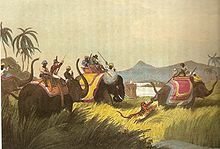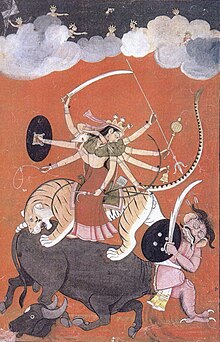Relation with humans
Tiger as prey
Main article: Tiger hunting
The tiger has been one of the Big Five game animals of Asia. Tiger hunting took place on a large scale in the early nineteenth and twentieth centuries, being a recognised and admired sport by the British in colonial India as well as the maharajas and aristocratic class of the erstwhile princely states of pre-independence India. Tiger hunting was done by some hunters on foot; others sat up on machans with a goat or buffalo tied out as bait; yet others on elephant-back.[128] In some cases, villagers beating drums were organised to drive the animals into the killing zone. Elaborate instructions were available for the skinning of tigers and there were taxidermists who specialised in the preparation of tiger skins.
Man-eating tigers
Main article: Tiger attack
Although humans are not regular prey for tigers, they have killed more people than any other cat, particularly in areas where population growth, logging, and farming have put pressure on tiger habitats. Most man-eating tigers are old and missing teeth, acquiring a taste for humans because of their inability to capture preferred prey.[129] Almost all tigers that are identified as man-eaters are quickly captured, shot, or poisoned. Unlike man-eating leopards, even established man-eating tigers will seldom enter human settlements, usually remaining at village outskirts.[130]Nevertheless, attacks in human villages do occur.[131] Man-eaters have been a particular problem in India and Bangladesh, especially in Kumaon, Garhwal and the Sundarbans mangrove swamps of Bengal, where some healthy tigers have been known to hunt humans. Because of rapid habitat loss due to climate change, tiger attacks have increased in the Sundarbans.[132]
A female tiger Tatiana escapedfrom her enclosure in the San Francisco Zoo, killing one person and seriously injuring two more before being shot and killed by the police. The enclosure had walls that were lower than they were legally required to be, allowing the tiger to climb the wall and escape.
Although humans are not regular prey for tigers, they have killed more people than any other cat, particularly in areas where population growth, logging, and farming have put pressure on tiger habitats. Most man-eating tigers are old and missing teeth, acquiring a taste for humans because of their inability to capture preferred prey.[129] Almost all tigers that are identified as man-eaters are quickly captured, shot, or poisoned. Unlike man-eating leopards, even established man-eating tigers will seldom enter human settlements, usually remaining at village outskirts.[130]Nevertheless, attacks in human villages do occur.[131] Man-eaters have been a particular problem in India and Bangladesh, especially in Kumaon, Garhwal and the Sundarbans mangrove swamps of Bengal, where some healthy tigers have been known to hunt humans. Because of rapid habitat loss due to climate change, tiger attacks have increased in the Sundarbans.[132]
A female tiger Tatiana escapedfrom her enclosure in the San Francisco Zoo, killing one person and seriously injuring two more before being shot and killed by the police. The enclosure had walls that were lower than they were legally required to be, allowing the tiger to climb the wall and escape.
Traditional Asian medicine
Many people in China have a belief that various tiger parts have medicinal properties, including as pain killers andaphrodisiacs.[133] There is no scientific evidence to support these beliefs. The use of tiger parts in pharmaceutical drugs in China is already banned, and the government has made some offenses in connection with tiger poaching punishable by death. Furthermore, all trade in tiger parts is illegal under the Convention on International Trade in Endangered Species of Wild Fauna and Flora and a domestic trade ban has been in place in China since 1993. Still, there are a number of tiger farms in the country specialising in breeding the cats for profit. It is estimated that between 5,000 and 10,000 captive-bred, semi-tame animals live in these farms today.[134][135][136]As pets
The Association of Zoos and Aquariums estimates that up to 12,000 tigers are being kept as private pets in the US, significantly more than the world's entire wild population; 4,000 are believed to be in captivity in Texasalone.[verification needed][137][138] Part of the reason for America's enormous tiger population relates to legislation. Only nineteen states have banned private ownership of tigers, fifteen require only a license, and sixteen states have no regulations at all.[139] The success of breeding programmes at American zoos and circuses led to an overabundance of cubs in the 1980s and 1990s, which drove down prices for the animals. The SPCA estimate there are now 500 lions, tigers and other big cats in private ownership just in the Houston area.[verification needed]Cultural depictions
The tiger replaces the lion as King of the Beasts in cultures of eastern Asia,[140]representing royalty, fearlessness and wrath.[141] Its forehead has a marking which resembles the Chinese character 王, which means "king"; consequently, many cartoon depictions of tigers in China and Korea are drawn with 王 on their forehead.[citation needed]
Of great importance in Chinese myth and culture, the tiger is one of the 12 Chinese zodiac animals. Also in various Chinese art and martial art, the tiger is depicted as an earth symbol and equal rival of the Chinese dragon- the two representing matter and spirit respectively. In fact, the Southern Chinese martial art Hung Ga is based on the movements of the Tiger and the Crane. In Imperial China, a tiger was the personification of war and often represented the highest army general (or present day defense secretary),[141] while the emperor and empress were represented by a dragon andphoenix, respectively. The White Tiger (Chinese: 白虎; pinyin: Bái Hǔ) is one of the Four Symbols of the Chinese constellations. It is sometimes called the White Tiger of the West (西方白虎), and it represents the west and the autumn season.[141]
In Buddhism, it is also one of the Three Senseless Creatures, symbolising anger, with the monkey representing greed and the deer lovesickness.[141]
The Tungusic people considered the Siberian tiger a near-deity and often referred to it as "Grandfather" or "Old man". The Udege and Nanai called it "Amba". TheManchu considered the Siberian tiger as Hu Lin, the king.[30]
The widely worshiped Hindu goddessDurga, an aspect of Devi-Parvati, is a ten-armed warrior who rides the tigress (or lioness) Damon into battle. In southern India the god Ayyappan was associated with a tiger.[142]
The weretiger replaces the werewolf in shapeshifting folklore in Asia;[143] in India they were evil sorcerers while in Indonesia and Malaysia they were somewhat more benign.[144]
The tiger continues to be a subject in literature; both Rudyard Kipling, in The Jungle Book, and William Blake, in Songs of Experience, depict the tiger as a menacing and fearful animal. In The Jungle Book, the tiger, Shere Khan, is the wicked mortal enemy of the protagonist, Mowgli. However, other depictions are more benign: Tigger, the tiger from A. A. Milne's Winnie-the-Pooh stories, is cuddly and likable. In the Man Booker Prize winning novel "Life of Pi", the protagonist, Pi Patel, sole human survivor of a ship wreck in the Pacific Ocean, befriends another survivor: a large Bengal Tiger. The famous comic strip Calvin and Hobbes features Calvin and his stuffed tiger, Hobbes. A tiger is also featured on the cover of the popular cereal Frosted Flakes (also marketed as "Frosties") bearing the name "Tony the Tiger".
The Tiger is the national animal of Bangladesh, Nepal, India[145] (Bengal Tiger), Malaysia (Malayan Tiger), North Korea andSouth Korea (Siberian Tiger).
World's favourite animal
In a poll conducted by Animal Planet, the tiger was voted the world's favourite
animal, narrowly beating the dog. More than 50,000 viewers from 73 countries voted in the poll. Tigers received 21% of the vote, dogs 20%, dolphins 13%, horses 10%,lions 9%, snakes 8%, followed by elephants, chimpanzees, orangutans and whales.[146][147][148][149]
Animal behaviourist Candy d'Sa, who worked with Animal Planet on the list, said: "We can relate to the tiger, as it is fierce and commanding on the outside, but noble and discerning on the inside".[146]
Callum Rankine, international species officer at the World Wildlife Federation conservation charity, said the result gave him hope. "If people are voting tigers as their favourite animal, it means they recognise their importance, and hopefully the need to ensure their survival," he said.[146]





No comments:
Post a Comment